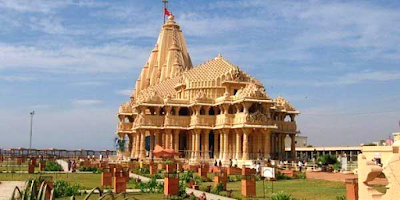Dwarka
Dwarka, located in the Devbhoomi Dwarka district of Gujarat, India, is one of the most significant and revered Hindu pilgrimage sites. Known as the ancient kingdom of Lord Krishna, it is one of the four Char Dham pilgrimage sites and holds immense religious, historical, and architectural importance. Here is a detailed guide to Dwarka as a tourist destination:
Historical and Religious Significance
Mythological Background: Dwarka is believed to have been the capital of Lord Krishna's kingdom. According to Hindu mythology, Krishna established his kingdom in Dwarka after leaving Mathura.
 |
| Gujrat |
Char Dham: It is one of the four sacred Char Dham pilgrimage sites, which also include Badrinath, Puri, and Rameswaram.
Major Attractions
Dwarkadhish Temple (Jagat Mandir)
Architecture: A magnificent five-story structure supported by 72 pillars, built in the Chalukya style of architecture.
 |
| Dwarka |
Deity: The temple is dedicated to Lord Krishna, worshipped here as Dwarkadhish or 'King of Dwarka'.
Highlights: The black marble idol of Krishna, the intricate carvings on the temple walls, and the flag changing ceremony on the temple spire.
Timings: Open from 6:30 AM to 1:00 PM and 5:00 PM to 9:30 PM.
Rukmini Devi Temple
Significance: Dedicated to Rukmini, the chief queen of Lord Krishna.
Architecture: Known for its beautiful carvings and artistic excellence.
 |
| Rukmini Devi Temple |
Location: Situated 2 km from the Dwarkadhish Temple.
Bet Dwarka (Beyt Dwarka)
Significance: Believed to be the original residence of Lord Krishna.
 |
| Bet Dwarka |
Access: Accessible by a short boat ride from Okha, which is 30 km from Dwarka.
Attractions:-Numerous temples, including the Keshavraiji temple, and scenic beaches.
Nageshwar Jyotirlinga Temple
Significance: One of the twelve Jyotirlinga shrines dedicated to Lord Shiva.
 |
| Nageshwar Jyotirlinga Temple |
Highlights: The giant statue of Lord Shiva and the tranquil surroundings.Location: About 17 km from Dwarka.
Gomti Ghat
Significance: Located at the confluence of the Gomti River and the Arabian Sea.
 |
| Gomti Ghat |
Activities: Pilgrims take a holy dip in the river, believing it to purify them from sins.Attractions: Several small shrines and the Chakra Narayan temple.
Bhadkeshwar Mahadev Temple
Location: Situated on a hillock and surrounded by the sea, offering stunning views.
Significance: Dedicated to Lord Shiva.
 |
| Beautifull View |
Special Feature: During high tide, the temple is surrounded by water, creating a captivating sight.
Sunset Point and Dwarka Beach
Activities: Enjoying the scenic beauty and relaxing by the beach.
Significance: Offers a picturesque view of the sunset over the Arabian Sea.
 |
| Sun Set View |
Activities
Pilgrimage and Temple Visits
Exploring the various temples and participating in the rituals and ceremonies.
 |
| Pilgrimage |
Attending the evening aarti at the Dwarkadhish Temple.
Boat Rides to Bet Dwarka
A short boat trip to Bet Dwarka provides an opportunity to enjoy the sea and visit the temples on the island.
Accommodation
Dwarka offers a range of accommodation options, from budget hotels to mid-range and luxury hotels. Many dharamshalas (pilgrim rest houses) are also available for devotees.
Tips for Visitors
Dress Code: Modest attire is recommended when visiting temples.
Local Customs: Respect local customs and traditions, especially within religious sites.
Safety: Be cautious around the beaches and during boat rides, as sea conditions can vary.
Dwarka is not just a place of religious significance but also a destination that offers rich cultural experiences and scenic beauty, making it a must-visit location in Gujarat.
 |
| Natural View |


























